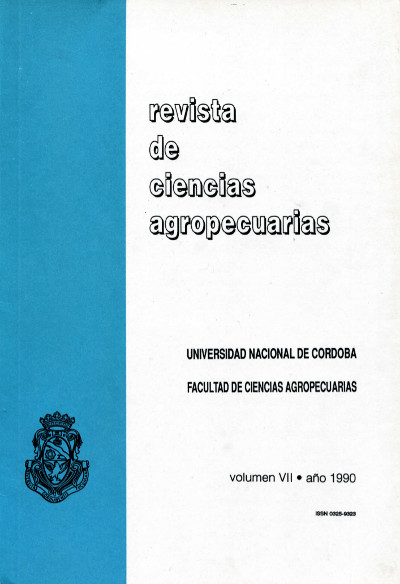Symbiotic association between Atriplex aff. cordobensis Gand et Stukert (Cariofilales) and Frankia sp. (Actinomycetales)
Main Article Content
Abstract
Among the symbiont diazotroph microorganisms in non-leguminous plants, the genus Frankia (Actinomycetales) is mentioned. A. aff. cordobensis (Caryophyllales) is a forage shrub which grows in soils with high alkalinity (pH: 8.5-9). In this paper we intend to prove the Atriplex-Frankia symbiotic relationship, to verify the presence of Actinomycetes in soils and to isolate the endophyte in an artificial QMOD medium. The Atriplex-Frankia symbiosis has been really proved. Besides, the plants growing in their native soil modulated regularly. This fact shows that, undoubtedly, the genus Frankia inhabits the studied soils of arid regions. The strains isolated from A. aff. cordobensis grew in the complex QMOD medium and showed the typical morphological characteristics of Actinomycetes.
Article Details

This work is licensed under a Creative Commons Attribution-ShareAlike 4.0 International License.
How to Cite
References
Alexander, A. (1980). Introducción a la Microbiología del suelo. A.G.T. Editor.
Ambrogio, A. (1986). Manual de Técnicas de Histología Vegetal. Ed. Hemisferio Sur.
Baker, D. (1987). Opportunities for autoecological studies of Frankia, a symbiotic Actinomycete. Program for Forest Microbiology, School of Forestry and Environmental Studies, Connecticut.
Backing, J. (1970). Frankiaceae fam. nov. (Actinomycetales) with one new combination and six new species of genus Frankia Brunchorst 1866, 174. International Journal of Systematic Bacteriology, 20(2), 201-220.
Buchanan, R., & Gibbons, E. (1974). Bergey's manual of Determinative Bacteriology (8th ed.). The Williams & Wilkins Company.
Callaham, D., Del Tredici, P., & Torrey, G. (1978). Isolation and cultivation in vitro of the Actinomycete causing root nodulation in Comptonia. Science, 199(4327), 899-902.
Fontaine, M., Lancelle, S., & Torrey, G. (1984). Initiation and ontogeny of vesicles in cultured Frankia sp. strain HFP Ar 13. Journal of Bacteriology, 3(3), 921-927.
Gauthier, D., Frioni, L., Diem, G., & Dommergues, Y. (1984). La simbiosis Colletia spinosissima - Frankia. Acta Ecológica, 5(3), 231-239.
Lalonde, M., & Calvert, H. (1979). Production of Frankia hyphae and spores as an infective inoculant for Alnus species. In J. C. Gordon, C. T. Wheeler, & A. Perry (Eds.), Symbiotic Nitrogen Fixation in the Management of Temperate Forests (pp. 95-110). Forest Research Laboratory, Corvallis.
Lechevalier, M. (1986). Nitrogen fixing actinomycetes of the genus Frankia. Waksman Institute of Microbiology, Rutgers, The State University of New Jersey. Proceedings of the IV International Symposium on Microbial Ecology, 253-256.
McKnight, T. (1949). Efficiency of isolates of Rhizobium in the cowpea group with proposed addition to this group. Journal of Agriculture, 6(2), 61-76.
Parsons, R., Silvester, B., Harris, S., Gruijters, W., & Bullivant, S. (1987). Frankia vesicles provide inducible and absolute oxygen protection for nitrogenase. Plant Physiology, 83(3), 728-731.
Pommer, E. (1959). Uber die isolierung des endophyten aus den wurzelknollchen Alnus glutinosa Gaertn, and uber erfolgreiche reinfektions-versuche. Berichte der Deutschen Botanischen Gesellschaft, 72(2), 138-150.
Pizarro, M., Ayerza, R., & Karlin, U. (1986). Management of arboreal Prosopis in agroforestry production systems in the Dry Chaco, Argentina. Proyecto de investigación, convenio NAS-FCA. BOSTID (Board of Science and Technology for International Development).
Quispel, A. (1974). The Biology of Nitrogen Fixation. North Holland Publishing Company.
Rodriguez-Barrueco, C., Subramanian, P., & Martins-Logao, M. (1982). La fijación biológica de nitrógeno atmosférico y la producción vegetal. Anuario del Centro de Edafología Aplicada, 221(1), 221-241.
Romero, M. (1981). Contribuciones al estudio del género Atriplex (Chenopodiaceae) en la Argentina, I. Darwiniana, 23(1), 119-150.
Ruschel, P. (1980). Curso rápido sobre tecnología de Rhizobium. MIRCEN/UNESCO.
Schlegel, G. (1979). Microbiología General. Ed. Omega.
Vanderbosh, A., & Torrey, G. (1984). Consequences of sporangial development for nodule function in root nodules of Comptonia peregrina and Myrica gale. Plant Physiology, 76(2), 556-560.
Vanderbosh, A., & Torrey, G. (1985). Development of endophytic Frankia sporangios in field and laboratory grown nodules of Comptonia peregrina and Myrica gale. American Journal of Botany, 72(1), 99-108.
Woronin, M. (1986). Uber die bei del Schwarzerle (Alnus glutinosa) and del gewohnlichen garten-lupine (Lupinus mutabilis) auftretenden Wurzelanschwellungen. Memoires de l'Académie des Sciences de St. Pétersbourg, 101(1), 101-110.
Zhongze, A., & Torrey, G. (1984). Initiation and ontogeny of vesicles in cultured Frankia sp. strain HFP arl3. Journal of Bacteriology, 3(3), 921-927.
Zhongze, A., & Torrey, G. (1985). Studies of an effective strain of Frankia from Allocasuarina lehmaniana of Casuarinaceae. Plant and Soil, 87(1), 61-78.





